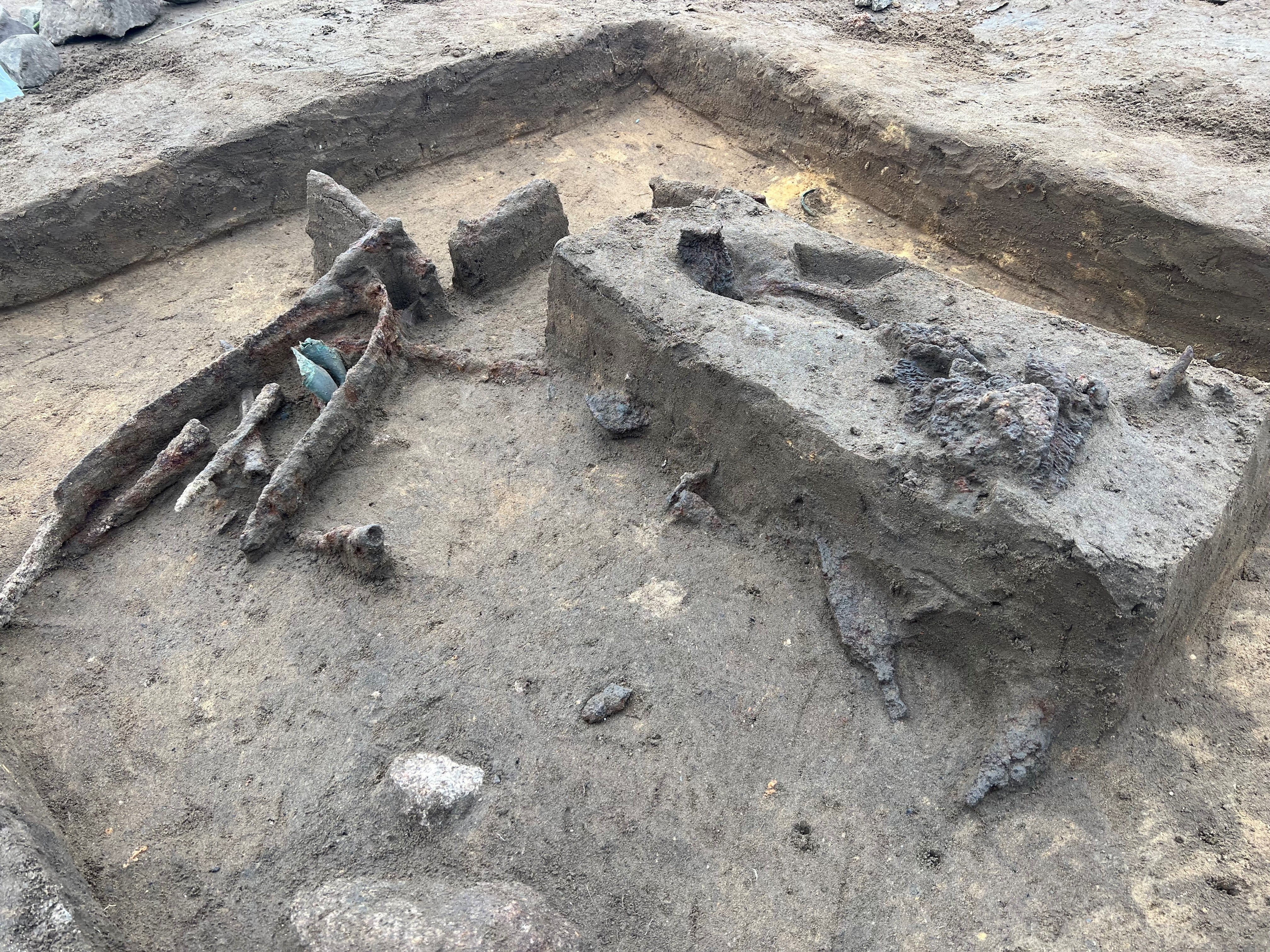
A Study of Weapon Sacrifices and Power Symbols at Løsning Søndermark
In August 2024, archaeologists from Vejle Museums uncovered an extraordinary Iron Age site at Løsning Søndermark, near Hedensted, Denmark. Conducted in conjunction with the expansion of the E45 motorway, this excavation revealed a treasure trove of artifacts and cultural layers spanning four centuries, from the beginning of the Common Era to approximately 450 CE. The findings include a remarkable array of weapons, rare chainmail, and symbolic bronze neck rings—artifacts that shed light on the social, military, and ritual practices of a warrior elite.
The discoveries at Løsning Søndermark, combined with their unique context within settlement structures, mark this as one of the most significant Iron Age finds in Scandinavia.
Layers of Time: Uncovering an Iron Age Settlement
Drone shot of the excavation at Løsning Søndermark, E45 (Photo: Vejlemuseere)
The site at Løsning Søndermark has provided an invaluable glimpse into daily life, warfare, and religious practices during the Iron Age. For over four centuries, the settlement evolved, accumulating a cultural layer rich with evidence of daily activities. Items such as ceramic fragments, slaughter waste, and personal items like pins paint a vivid picture of life in this era.
However, by the early 5th century, the settlement had grown in significance, transforming into a hub of power. The site housed individuals capable of amassing warrior retinues, possessing the wealth and influence needed to engage in warfare and perform grand ceremonial acts.
Houses of the Elite
More than 100 sacrificial spears and lances have been found so far (Photo: Vejlemuseere)
Central to the discovery are two structures linked to the elite residents of the settlement. Both buildings contained roof-bearing postholes filled with weapons, including lances, spears, swords, and chainmail. These weapons were not discarded remnants of a forge or barracks but were part of ritualized offerings.
The deposits in these structures reveal a stark contrast in intent and execution:
- In one building, weapons were placed in the postholes during the house's demolition, possibly signifying the end of its functional life.
- In the other, weapons were tightly packed around the posts during construction, perhaps symbolizing a foundation ritual.
These acts indicate a powerful symbolic connection between warfare, social status, and the sacred.
Chainmail: A Rare Mark of the Warrior Elite
Among the most striking finds is a nearly intact chainmail shirt, a rarity in Iron Age Scandinavia. This is the first such artifact discovered within a settlement context, as chainmail is typically found in burials or bogs.
The well-preserved chainmail (Photo: Vejlemuseere)
The production of chainmail required exceptional skill, access to resources, and extensive labor, making it an elite status symbol. Its presence at Løsning Søndermark underscores the site's importance as a seat of power.
Comparable examples of elite warrior burials, such as the Brokær grave in Southwest Jutland, highlight the exclusivity of such armor. These burials often included other high-value items like Roman imports, gold rings, and ceremonial drinking horns.
Oath Rings and Symbols of Authority
In addition to weapons and armor, fragments of two bronze neck rings were found within one structure. These artifacts closely resemble oath rings depicted on Nordic gold bracteates, such as those from the famed Vindelev Hoard.
"Part of oath ring. Well-known symbol of power from the pictorial world of the Iron Age" (Photo: Vejlemuseere)
The Ring Bearer Motif
The ring bearer, a figure often shown holding an oath ring, symbolizes power, authority, and influence. The rings at Løsning Søndermark likely served a similar ceremonial purpose and may have belonged to the settlement’s elite. Interestingly, some depictions of ring bearers, such as those on the Vindelev bracteates, show them wearing garments with patterns that may represent chainmail, further tying these artifacts to the warrior elite.
Sacrifice or Spoils? Interpreting the Weapon Deposits

Swords and other weapons (Photo: Vejlemuseere)
The exact purpose of the weapon sacrifices remains a subject of ongoing investigation. The weapons may represent:
- Sacrifices to Deities: Offerings to higher powers in gratitude for military victories or to ensure future success.
- War Booty: Spoils of war from defeated enemies, reminiscent of the large-scale weapon deposits in bogs, such as those at Illerup Ådal near Skanderborg.
In either case, the offerings were steeped in symbolic meaning, reflecting the deep interconnection between warfare, religious practice, and social hierarchy in the Iron Age.
Conclusion: A Window into Iron Age Power Dynamics
The findings at Løsning Søndermark offer a rare and detailed insight into the lives of Iron Age elites. The weapon sacrifices, chainmail, and oath rings speak to a society where power was demonstrated not only through military might but also through ritual and symbolism.
As excavation and analysis continue, we hope to gain a clearer understanding of the site's role in regional power dynamics, its connections to other significant Iron Age sites, and the rituals that defined its existence. This discovery stands as a testament to the complexity and richness of Iron Age culture, offering us a direct link to the lives of those who once walked this land.
Those interested in seeing all media for this excavation can visit here.
A very large lance found in the excavation (Photo: Vejlemuseere)
References
Axboe, M. (2022). The World's Largest Gold Bracteate: A Brief Presentation of the Migration Period Gold Hoard from Vindelev, Denmark. The European Archaeologist, 74, 54-61.
Grundvad, L. (2021). Iron Age Offerings from Stavsager Høj near Fæsted – A Preliminary Presentation of Deposits and Contexts. Archaeology in Schleswig, 18, 119-138.
Ilkjær, J. (2000). Illerup Ådal – An Archaeological Magic Mirror. Højbjerg: Moesgård Museum.
Pesch, A. (2022). Die Kraft der Tiere: Völkerwanderungszeitliche Goldhalskragen und die Grundsätze Germanischer Kunst. Heidelberg: Propylaeum.
Rasmussen, B. M. (1995). Brokær: A Center of Wealth in the Roman Empire in Southwest Jutland. Acta Archaeologica, 66, 39-109.
Wijnhoven, M. A. (2021). European Mail Armour: Ringed Battle Shirts from the Iron Age, Roman Period and Early Middle Ages. Amsterdam: Amsterdam University Press.








